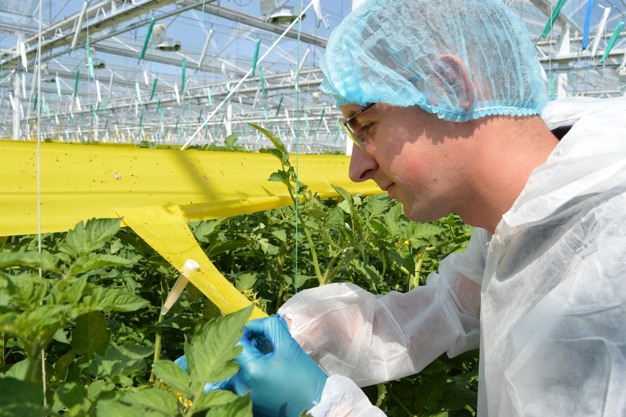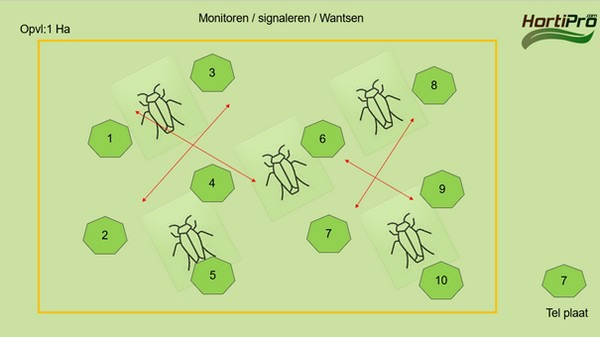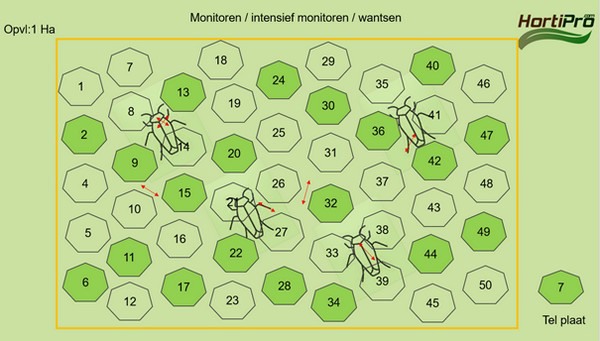"We have definitely spotted Nesi," confirms Lennart Simonse of HortiPro in mid-May. In tomato cultivation, the predatory bug, officially known as Nesidiocoris tenuis, is feared. To closely monitor the development of the infestation, growers use the PheroNesi pheromone. However, they do not always do this properly, risking an infestation getting out of control. Lennart emphasizes the importance of a good distribution of PheroNesi pheromones throughout the greenhouse below.
Growers keep an eye on the development of the Nesi infestation with the help of PheroNesi, but Lennart also conducts counts at growers. The practical researcher of biological crop protection at HortiPro does this for several pests, including Tuta absoluta. "But I get the impression that Nesi is currently a bigger problem in tomato cultivation. I have seen Tuta very little."

Lennart during a control round at a PheroNesi pheromone
Suppressing the population development of predatory bugs with pheromones
He is currently tracking the population development of Nesidiocoris tenuis. To signal effectively, HortiPro advises an even distribution of 10 pheromones per hectare. "What we sometimes encounter in practice is a false economy, where the pheromones are only hung in a corner of the greenhouse where the grower expects the pest. If Nesi then appears elsewhere, there's a risk of being too late, resulting in crop damage."
The PheroNesi pheromone attracts both males and females to the yellow sticky trap at the top of the greenhouse. The product has been available on the Dutch market for almost two years. Internationally, growers also use it, including in France. "There, the number of available and usable crop protection agents against Nesi is even more limited, making the problem with Nesi even greater there."
Intensive monitoring of Nesidiocoris tenuis
The beauty of PheroNesi, according to Lennart, is that growers can easily scale up as needed. "This is about scaling up from signaling, with 10 pheromones per hectare, to monitoring, where we advise distributing 20 units evenly per hectare." Hanging up even more pheromones is possible. "Then we're talking about intensive monitoring, involving sometimes up to 50 to more than 100 sticky traps with a PheroNesi pheromone per hectare. This certainly happens abroad."

Even distribution for signaling with PheroNesi
A grower prefers to stick to signaling as long as possible, but Lennart has also encountered situations where scaling up to 50 PheroNesi units per hectare was necessary for intensive monitoring of the infestation. "And in a few cases, the top of the plant has been cleaned up. There, the grower was too late in scaling up. Nesi is often found at the top of the plant. The biological control agent, Macrolophus, is located lower down."
 Even distribution in the case of intensive monitoring with PheroNesi
Even distribution in the case of intensive monitoring with PheroNesi
Predicting the population pressure of predatory bugs remains challenging
Spraying is a last resort, as everyone knows. Grower Eric Volkering of Greenway said last year: "Hanging the pheromones is a bit of work, but after that, it almost works by itself. It prevents the need for spraying, and that's what you want because then you're in trouble. It costs you your biology, and every spraying also means a slight growth delay."
The advisors of HortiPro only provide advice in practice. It is the grower himself who decides what to do, emphasizes Lennart. More data and knowledge about when the onset of Nesi is coming would be welcome, he knows, but we are not there yet. "With more data on the effect of temperature, you would like to eventually make a calculation to predict population pressure."
What exactly the dark and occasionally also relatively cold spring means for the onset of PheroNesi remains to be seen. However, it is known what the start period does with plants. "A lot depends on your starting situation. At the start of the cultivation in the fall, the chance of Nesi development is generally already higher than with a winter planting. In the latter case, Nesi has had less time to develop."
Prevention is also here, as is increasingly the case with crop protection in the greenhouse, better than cure. PheroNesi has already become a well-established tool for this purpose.
For more information:
Lennart Simonse
HortiPro
[email protected]
www.hortipro.com
